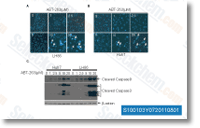To test the speci fic purpose of Snail1 in up regulating TISC characteristics, we utilized siRNA to knock down Snail1 in mesenchy mal cells. Soon after Snail1 siRNA remedy, TISC markers Nanog and CD44 decreased significantly, which was related with decreased spheroid formation and decreased migration. TGFb regulates Snail and Nanog by means of Smad signaling The primary mechanism of TGFb induced EMT is by means of Smad dependent signaling. Following activation selleck chemical PD0325901 of TGFb receptors, Smad2 and Smad3 are phosphorylated and form the Smad234 heterocomplex, which translocates for the nucleus to manage Snail1 transcription. Following TGFb stimulation in epithelial cells, Snail1 greater. In order to verify that TGFb induces Snail1 via Smad dependent pathways in our model, we utilized inhibitory Smads, Smad7 and dominant detrimental Smad3, which block heterocomplex formation.
Epithelial cells kinase inhibitor Tosedostat had been transfected with Smad7 or Smad3 vectors 24 hours prior to TGFb stimulation. qPCR and western blot evaluation demonstrated that inhibitory Smads signifi cantly attenuated TGFb induced Snail1 up regulation. TGFb regulates Nanog promoter activity by way of Smad signaling in human embryonic stem cells. To verify that TGFb can induce Nanog promoter activity in our model, epithelial cells were co transfected with Nanog Luc and Smad7 or Smad3 vectors. Following TGFb stimulation, Nanog Luc action was substantially attenuated by inhibitory Smads, indi cating that TGFb stimulates Nanog promoter exercise as a result of Smad dependent signaling. Snail1 straight regulates Nanog promoter Right after transient knock down of Snail1, Nanog expression is decreased, indicating that Snail1 directly regulates TISC genes in mesenchymal cells. To additional investigate this Snail1 driven TISC expression profile, we established steady Snail1 knock down in mesenchymal Snail1 shRNA cells.
In these mesenchymal Snail1 shRNA cells, down regulation of Snail1 corresponded to decreased Nanog promoter  exercise and decreased Nanog and CD44 expression. Inhibition of Snail1 benefits in decreased tumor growth in vivo As demonstrated, Snail1 is a key regulator of TISC charac teristics in vitro. To investigate the role of Snail1 in tumor initiation, we inoculated 1 ? 104 mesenchymal Snail1 shRNA cells into nude mice. The mesenchymal Snail1 shRNA cells show diminished in tumor growth com pared to regulate mesenchymal cells. Examination of tumors demonstrates that Snail1 expression was down regulated in one ? 104 cell initiated tumors from mesenchymal Snail1 siR cells. Nevertheless, tumor initiation was not affected by Snail1 suppression, as evidence by all inocula tions forming tumors, even in Snail1 inhibited cells. Epithelial and mesenchymal distinctions in human HCC In order to investigate SNAIL1 and NANOG expression in human HCC cells, we utilized Huh7 and MHCC97 L cells.
exercise and decreased Nanog and CD44 expression. Inhibition of Snail1 benefits in decreased tumor growth in vivo As demonstrated, Snail1 is a key regulator of TISC charac teristics in vitro. To investigate the role of Snail1 in tumor initiation, we inoculated 1 ? 104 mesenchymal Snail1 shRNA cells into nude mice. The mesenchymal Snail1 shRNA cells show diminished in tumor growth com pared to regulate mesenchymal cells. Examination of tumors demonstrates that Snail1 expression was down regulated in one ? 104 cell initiated tumors from mesenchymal Snail1 siR cells. Nevertheless, tumor initiation was not affected by Snail1 suppression, as evidence by all inocula tions forming tumors, even in Snail1 inhibited cells. Epithelial and mesenchymal distinctions in human HCC In order to investigate SNAIL1 and NANOG expression in human HCC cells, we utilized Huh7 and MHCC97 L cells.
PKA Signal
PKA signal is required for initiation
